

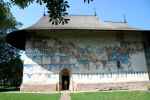
In 1502 Luka Arbore, the castellan of Suceava, received a small village (from Stephen III the Great) in acknowledgement for his deserts in the battle against King John Albert’s1 Polish troops. The village owes its name to him – Arbore – as well as its fame: its fame, because between April 2 and August 29 of that same year Luka Arbore built in his new village a beautiful painted church of Saint John the Baptist, which since 1993 has been included on the UNESCO's World Heritage List.
ATTENTION! Everyone who visited Romania or is planning to go there soon is kindly invited to contribute to this guide. Any inquires regarding this matter should be referred to the editor's address redakcja@libertas.pl.
The church was built on a rectangular plan with one abse to the east; the role of the lateral apsides play small recesses in the wall, totally not visible from the outside. The church is covered with a wide roof, but as a boyar's temple, and not of a prince, just as the Humor church, it does not have a tower. An interesting architectural element is an arcade niche in the west wall, where once the bells were held.
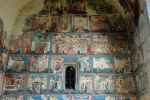


The exterior and the interior murals were painted in 1541 by order of Ana, Luka Arbore's niece. In 17th century, over a longer period of time, the temple was devoid of the roof, that is why, perhaps, the best-preserved murals are on the west wall, protected partly by the arcade. In the rectangular frames we can see the scenes from the Book of Genesis, saints and martyrs. Far worse preserved are the murals on the south wall, illustrating the Marian Akhatist. On the apse only the blue background has been preserved. On the north wall I cannot see any murals. I do not know whether they have never existed, or whether the atmospheric conditions turned out to be particularly unfriendly to them.
Inside the church there are gravestones of the temple’s founder – Luka Arbore – and his sons, Theodore and Nikita, who were beheaded at Stephen the Great's order in 1523. Well, great men's favours are uncertain.


The church in Arbore presents itself less richly than even Voronet (Voroneţ) Monastery, perhaps, but it has its own unique atmosphere. Maybe it is also thanks to the fact that there are visibly less tourists here. Some children are sitting under the arcade of the west wall, some lady is sitting under the tree and reading... Instead of crowds and innumerable stalls with souvenirs – peace and quiet, which surely suits a temple better. I was enchanted by this place, and most readily I would stay here until dusk, reading some mediaeval mystic... However, I warn that those who are looking for something different whatsoever may be disappointed.
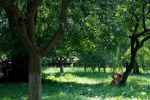
One of the most beautiful and best fortified monasteries in Bucovina is situated in Sucevita, which is confirmed by the fact that in 2010 this object was added to the UNESCO World Heritage List.
The monastery was founded by three brothers: George, Jeremy and Simon from the princely family of Mohyla (Movila). The monastery church of the Resurrection was probably raised between 1582 and 1584. In 1595 fortified walls and four corner towers, as well as a gate were built. The monastery outlasted all those years without falling into great disrepair, therefore it presents itself exceptionally imposingly.
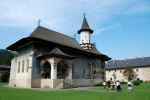

The church was built on a clover plan; onto the closed west porch on its both sides two open porches abut, through which up the stairs we enter the temple. Behind the porch there is a pronaos, and farther a burial chamber and a naos with three apsides topped by a beautiful octagonal tower resting on a dodecagonal foundation. The temple is covered, of course, with a characteristic wide shingled roof.
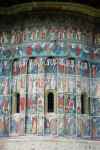


The external walls are adorned with beautiful mural paintings, considered as the top achievement of mediaeval church painting in Moldavia. At the very top of the north wall one can see The Creation of Adam and Eve, ended with their banishment from Heaven, and underneath the Ladder of Monastic Virtues, or in simple words, The Ladder to Heaven; on the apsides – The Celestial Hierarchy; on the south wall – The Tree of Jesse and an illustration of the Marian Akhatist with a scene of the siege of Constantinople. Curiously enough, underneath we can see the redeemed ancient philosophers: Aristotle, Pythagoras, Plato, among others.
Equally beautiful are the internal mural paintings, e.g. The Last Judgment in the porch. In the burial chamber brothers Jeremy and Simon – the founders of the church – are buried. In the altar abse there is a beautiful iconostasis from 1801. The most precious, however, is the 16th century icon of the Mother of God and Infant Christ.
We have seen only four out of all painted churches of Bucovina, but they made a big impression on us. While visiting these beautiful temples, I recollected the Tales of Bygone Years, in which Nestor described how knyaz Vladimir was considering what religion to adopt. Before taking the decision, he sent a delegation which had to visit a mosque of Muslims in Bulgaria, a church of Catholics in Germany and an eastern church. And here is the passage in which Nestor recalls the account of the visit to Constantinople:
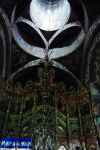

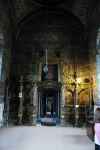
„(...) and the prince called together his vassals and the elders. Vladimir then announced the return of the envoys who had been sent out, and suggested that their report be heard. He thus commanded them to speak out before his vassals. The envoys reported: "(...) Then we went on to Greece, and the Greeks led us to the edifices where they worship their God, and we knew not whether we were in heaven or on earth. For on earth there is no such splendor or such beauty, and we are at a loss how to describe it. We know only that God dwells there among men, and their service is fairer than the ceremonies of other nations. For we cannot forget that beauty. Every man, after tasting something sweet, is afterward unwilling to accept that which is bitter, and therefore we cannot dwell longer here." Then the vassals spoke and said, "If the Greek faith were evil, it would not have been adopted by your grandmother Olga, who was wiser than all other men."
I do not know how in 987 the churches of Constantinople which the envoys of Vladimir saw looked like, but the painted churches of Bucovina really create an impression of unearthly ones! Actually, leaving this, already last on our route, temple in Sucevita, I could repeat their words from before a thousand years: “and they led us to the edifices where they worship their God, and we knew not whether we were in heaven or on earth.”
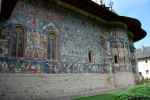
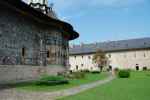
1. In 1497 King John I Albert set off at the head of a 50 thousand army towards the southeast to recapture from the hands of the Turks the important Black Sea ports: Killia and Bilhorod. Everything indicates that he had also planned to put on the Moldavian throne his brother Sigmundus, which the hospodar Stephen III the Great surely did not like. The latter cleverly changed sides and signed a pact with the Turks. John Albert for almost a month besieged Suceava with no result, in the end he decided to retreat, choosing carelessly a short cut across the Bucovina gorges and woods. In one of them Stephen III the Great prepared an ambush, and later on he harassed those who had survived till the border. It is estimated that every fifth participant did not return from Moldavia. The expedition ended with a complete defeat and everybody has surely heard the saying: In the time of King Albert, the noblemen became extinct
. Nota bene, it did not concern the noblemen lost during the expedition, but the noblemen who were punished by the king after he returned, for not answering the call to arms, when he called the general levy.
Nestor, Tale of Bygone Years, chapter 38.
Rumunia - przewodnik:
Satu Mare / Satmar (Romania) – guidebook (52 zdjęcia)Săpânţa - The Merry Cemetery (Romania) – guidebook (35 zdjęć)Bârsana Maramureş (Romania)– guidebook (48 zdjęć)Humor / Mănăstirea Humorului and Voronet / Voroneţ (Romania) – guidebook (32 zdjęcia)Arbore and Sucevita Monastery / Mănăstirea Suceviţa (Romania) – guidebook (43 zdjęcia)Cacica (Romania) – guidebook (21 zdjęć)Vama Veche (Romania) – guidebook (94 zdjęcia)Brasov (Romania) – guidebook (68 zdjęć)Curtea de Argeş (Romania) – guidebook (31 zdjęć)The Transfagarasan Road / Transfăgărăşan – guidebook (68 zdjęć)Sibiu / Hermannstadt (Romania) – guidebook (86 zdjęć)Hunedoara / Vajdahunyad (Romania) – guidebook (57 zdjęć)Bear Cave / Peştera Urşilor (Romania) – guidebook (29 zdjęć)Ştefan Hruşcă – kolędnik z SiedmiogroduSighetu Marmației (Romania) – guidebook (9 zdjęć)Kościoły Obronne Siedmiogrodu (Rumunia) – przewodnik (25 zdjęć)Rimetea / Torocko at the Rock of Szeklers (Romania) – guidebook (21 zdjęć)Konstanca / Constanța (Rumunia) – przewodnik (22 zdjęcia)Sighișoara (Romania) – guidebook (28 zdjęć)Mărginimea Sibiului (Romania) – guidebook (41 zdjęć)Wąwóz Galbeny / Cheile Galbenei (Rumunia) – przewodnik (23 zdjęcia)Twierdza Ponoru / Cetatile Ponorului (Rumunia) – przewodnik (19 zdjęć)Płaskowyż Padisz / Padiș (Rumunia) – przewodnik (52 zdjęcia)Wąwóz Râmeț / Cheile Râmețului (Rumunia) – przewodnik (29 zdjęć)Góry Fogaraskie – wokół jeziora Bâlea (Rumunia) – przewodnik (24 zdjęcia)